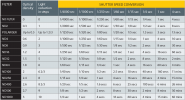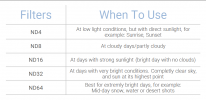Which ND filter to use for which video FPS? I always was guessing. I created a sheet for everyone to use to know ND filter you should be using!Fill in the FPS (for example 30) and what the camera of the drone measures for the light exposure (for example at a bright day 1/4000 s) and the sheet calculates the ND filter you should use:

 docs.google.com
docs.google.com
Feedback is welcome

Video and use ND filters
Feedback is welcome












